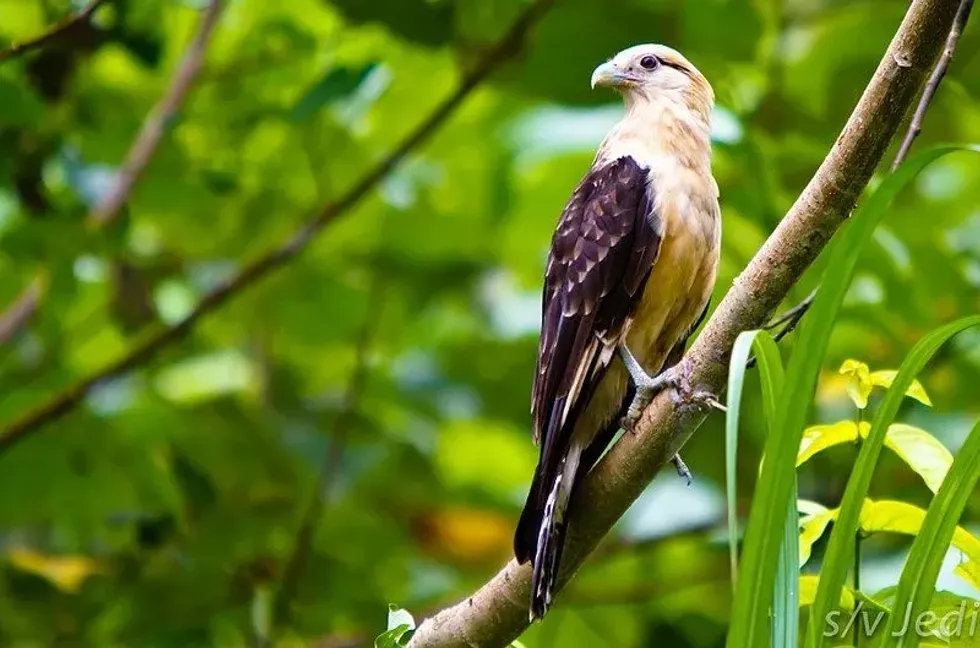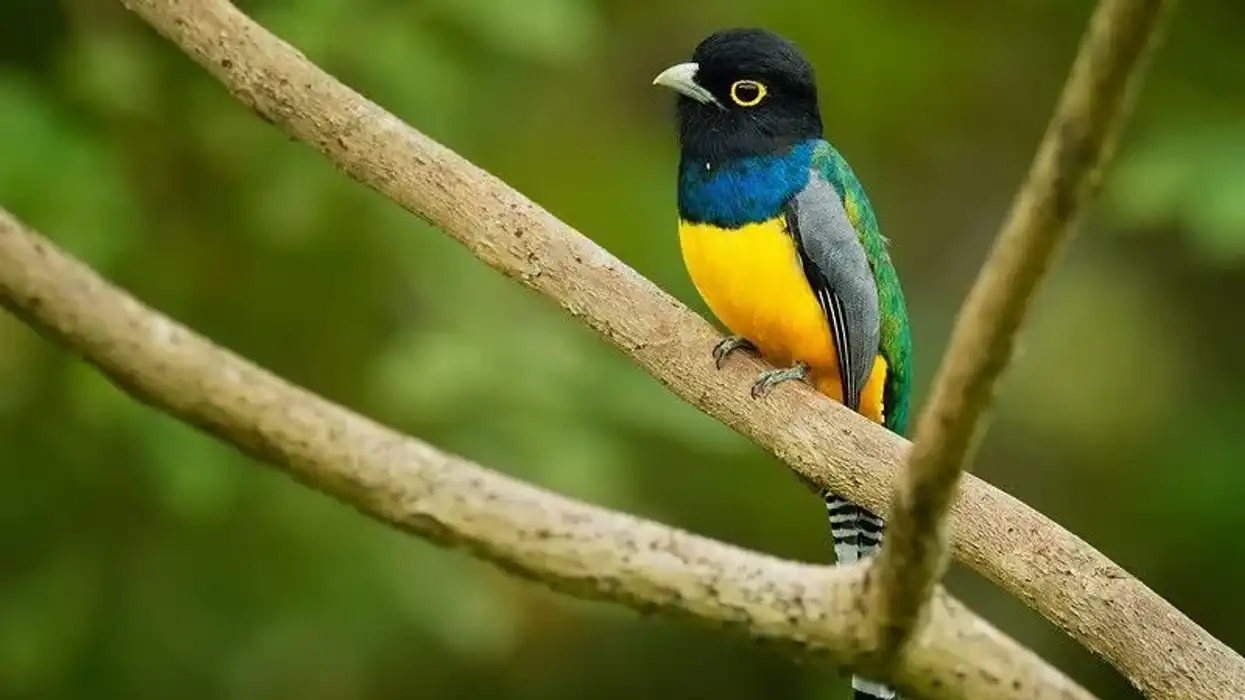The yellow-headed caracara (Milvago chimachima) of the Falconidae family is a bird of prey. They are not fast-flying aerial birds and usually scavenge food. A yellow-headed caracara (Milvago chimachima) is rather sluggish and often walks on the ground unlike the other falcons of this family.
They were first discovered by Louis Pierre Vieillot in 1816. He found this black and yellow bird and gave this caracara species the scientific name, Polyborus chimachima.
They were also put into the same genus as crested caracaras. Later, the Milvago genus was created by the German naturalist Johann Baptist von Spix in 1824. They are now closely related to the chimango caracara bird.
A yellow-headed caracara is omnivorous and its diet consists of carrions and small animals. They are widely found in south-central America and tropical and subtropical regions of South America.
These birds spend most of their time walking. This species of bird will not produce warning calls even in a closed habitat as they benefit from forest clearing. This species of bird is also referred to as tick birds.
If you find these facts about yellow-headed caracaras interesting, you may also enjoy learning about nene goose and oak titmouse.
Yellow-Headed Caracara Interesting Facts
What type of animal is a yellow-headed caracara?
The yellow-headed caracara species are neotropical birds and are active during the day. Previously given the name, Polyborus chimachima by Vieillot in 1816, these birds are rather sluggish and often spend their time walking and scavenging for food on ground.
They are a member of Falconidae family and genus Milvago of animals. They are omnivorous and can be found eating on rice fields and roads.
The normal behavior of this bird is picking out ticks on cattle and Baird's tapir (Tapirus bairdii). This is how they got their other name of tick birds.
What class of animal does a yellow-headed caracara belong to?
A yellow-headed caracara (Milvago chimachima) belongs to the Aves class of animals.
How many yellow-headed caracaras are there in the world?
The clearing of forests is beneficial to these birds which means that population of this species is increasing. The exact number of their population is unknown.
Where does a yellow-headed caracara live?
A yellow-headed caracara (Milvago chimachima) inhabits South America, Costa Rica, the northern and southern portion of Argentina, and Trinidad and Tobago. They are common birds in Latin American cities and cattle countries.
They occupy provinces of Formosa, Chaco, Misiones, Santa Fe, and Corrientes. They are expanding their range to Nicaragua. Chimango caracaras replaced the yellow-headed caracara (Milvago chimachima) in the southern areas of South America.
What is a yellow-headed caracara's habitat?
Yellow-headed caracaras (Milvago chimachima) can be found living in swamps, savannah, and forest edges in Costa Rica, southern and northern Argentina, and Trinidad and Tobago. They are typically found living at around 1,800 m (5,900 ft) or 2,600 m (8,500 ft) above sea level. They are found in open areas and around cattle.
Who do yellow-headed caracaras live with?
An adult yellow-headed caracara (Milvago chimachima) lives in pairs after breeding.
How long does a yellow-headed caracara live?
In the wild, these birds can live for up to 12 years.
How do they reproduce?
Both females and males of this species build nests and create a territory in a low tree or in old nests of other species. The nests are cup-shaped made out of sticks, rags, and horsehair.
This nesting process takes place from March to July. Both male and female yellow-headed caracaras take part in the incubation, hatching, feeding, and guarding process.
Females lay two to three eggs in the nest. These eggs are reddish-buff and are spherical with blotched brown. Young birds remain with their parents from June to August.
What is their conservation status?
Previously known as Polyborus chimachima by Vieillot in 1816), this species is listed as Least Concern in the IUCN Red List. The population of these birds increases with deforestation. In Costa Rica, the number of yellow-headed caracaras is actually expanding. They are at lower risk in South America because of the high rates of deforestation.
Yellow-Headed Caracara Fun Facts
What do yellow-headed caracaras look like?
Yellow-headed caracaras of South America, previously known as Polyborus chimachima, display no significant sexual dimorphism. A female weighs 0.68-0.8 lb (0.31-0.36 kg) whereas a male weighs 0.61-0.72 lb (0.28-0.33 kg ). They have a long tail and broad wings similar to Buteo.
Adult yellow-headed caracaras have a brown marked buff head. They have buff underpants and a black streak behind the eye.
An immature bird contains dense brown mottling on their head and underparts. They have a brown upper plumage and brown and cream feathers. Also, these young caracaras have pale patches on their flight wing feathers.
How cute are they?
As the name suggests, their yellow head makes them look moderately cute.
How do they communicate?
Their voice has a definite 'schreee'. Sometimes this species of the Falconidae family communicate through their body language and behavioral display.
How big is a yellow-headed caracara?
A yellow-headed caracara is 16-18 in (41-46 cm) long. An adult female is larger than male.
How fast can a yellow-headed caracara fly?
This species is not fast. They are sluggish and they walk on the ground rather than fly. This means that this bird is thought to be sedentary and does not migrate.
How much does a yellow-headed caracara weigh?
The average weight of this bird is 0.71 lb (0.32 kg). A female weighs 0.68-0.8 lb (0.31-0.36 kg) whereas a male weighs 0.61-0.72 lb (0.28-0.33 kg).
What are their male and female names of the species?
There are no specific names given to females or males.
What would you call a baby yellow-headed caracara?
There are no specific names given to the younger birds of this species.
What do they eat?
They feed on small animals, garbage, feces, and carrion. Their diet also includes crabs, fish, snakes, lizards, flying ants, and large insects. This species hunts mostly on the ground and eats small prey. They are also known as tick birds because they eat ticks off cattle. They feed on the scraps left behind by hawks.
Are they dangerous?
No, a yellow-headed caracara is not dangerous.
Would they make a good pet?
No, this species of bird would not make a good pet. Only professionals with experience can handle them.
Did you know...
A yellow-headed caracara was first recorded in Costa Rica in 1973.
Milvago chimachima readei, a stouter and larger paleosubspecies of this bird occurred thousands of years ago in Florida.
Yellow-headed caracara pairs are commonly seen on rooftops in suburban neighborhoods.
As they feed on ticks, they are called 'piopio' or 'garrapatero' in Santa Marta, Columbia.
How many eggs do yellow-headed caracaras lay?
A female yellow-headed caracara lays two to three eggs.
Is a yellow-headed caracara a bird of prey?
Yes, this raptor is a bird of prey and they primarily hunt and eat vertebrates. This bird of south America has good eyesight which they use to help them see long distances and while they are flying.
Their beaks and talons are robust. Even though they sluggish and not a fast-flying aerial bird, they prey on a variety of animals. This tropical dry species is a fish eagle.
Here at Kidadl, we have carefully created lots of interesting family-friendly animal facts for everyone to discover! Learn more about some other birds including black tern or red bird of paradise.
You can even occupy yourself at home by drawing one on our crested caracara coloring pages.










